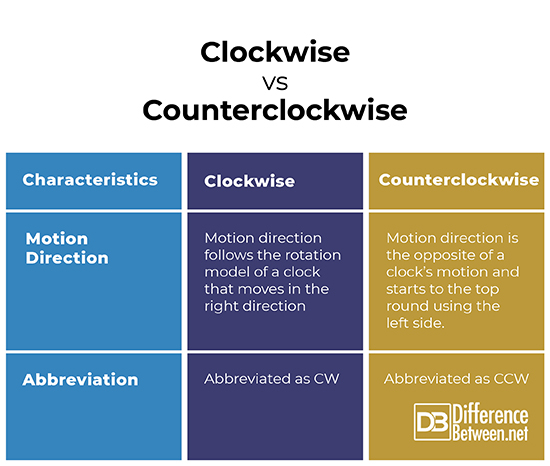Difference Between Clockwise and Counter-clockwise
Both clockwise and counterclockwise are adverbs that describe the movement of an object in the right or left direction. The movement is usually in a circular fashion which means it’s to the right at the top and the left at the bottom of the circle respectively for clockwise. For counterclockwise (also referred to as anti-clockwise), the direction is in the opposite direction of the clockwise rotation.
As adjectives, clockwise means moving in a rotary motion like a clock does while counterclockwise is moving in a rotary manner to the left side.
Meaning of Clockwise
Clockwise (usually abbreviated as CW) is the motion that proceeds in a similar direction as a clock’s hands. The movement is usually from the top going around to the right, then to the bottom, to the left, and then back to the top position.
Meaning of Counterclockwise
Counterclockwise (North American English and abbreviated as CCW) is the opposite sense of the clockwise rotation. The movement, in this case, starts from the top, heads to the right, goes down, then follows to the right side, and ends up at the top place. The rotation is also referred to as anticlockwise (ACW) according to the Commonwealth English.
Difference Between Clockwise and Counterclockwise
The major difference between the two rotations is in the direction they take.
Rotation Direction
In clockwise rotation, the motion starts from the top position, heads to the right side, goes to the bottom area, heads to the left, and finally goes up to the top position. Counterclockwise, on the other hand, starts from the top position, goes to the left side, proceeds down to the bottom position, then heads to the right side, and finally ends up on the top position.
Abbreviation
The clockwise motion is abbreviated as CW while the counterclockwise motion is abbreviated as CCW (can also be ACW if using the Commonwealth English versions that refers to it as anticlockwise).
Clockwise Vs. Counterclockwise
Summary of Clockwise Vs. Counterclockwise
The clockwise (CW) and counterclockwise (CCW) terms are used mostly together but for different purposes. Apart from the clock that uses the clockwise motion alone, other fields like Mathematics and Physics use the two. A case to point out is how taps and faucets are closed, and screws and bolts are tightened by turning them clockwise and released by turning them counterclockwise respectively.
- Difference Between Minecraft and Terraria - August 7, 2020
- Difference Between Alliteration and Onomatopoeia Poems - July 25, 2019
- Difference Between Certification and Licensure - July 24, 2019
Search DifferenceBetween.net :
1 Comment
Leave a Response
References :
[0]Image credit: https://upload.wikimedia.org/wikipedia/commons/thumb/3/38/Counterclockwise_Arrow.svg/500px-Counterclockwise_Arrow.svg.png
[1]Image credit: https://upload.wikimedia.org/wikipedia/commons/thumb/0/0a/Clockwise.svg/500px-Clockwise.svg.png
[2]"Clockwise And Counterclockwise". Mathsisfun.Com, 2019, https://www.mathsisfun.com/geometry/clockwise-counterclockwise.html.
[3]Definitions, C, and Computer Hope. "What Is CCW (Counterclockwise)?". Computerhope.Com, 2019, https://www.computerhope.com/jargon/c/ccw.htm.




Hi, I had to replace my toilet fill valve by taking it out of the toilet and putting it back in. The water connector and the locknut had to be removed and then replaced and the water had to be turned off and on. The instructions in the booklet was referring to direction of right as counterclockwise and the direction of left as clockwise. This was all too confusing. You know I understand right as clockwise and left as counterclockwise and righty tighty as right and lefty loosey as left but this book of directions seemed to be backwards.I just thought that maybe terms are reversed for plumbing and if not how can a huge company get it so reversed. Anyway this is my comment for this day.